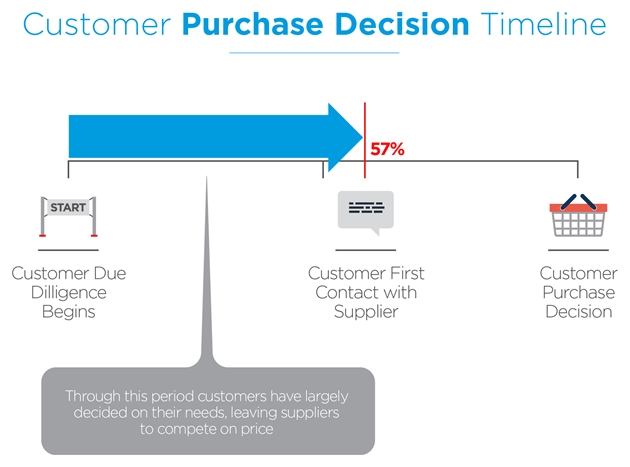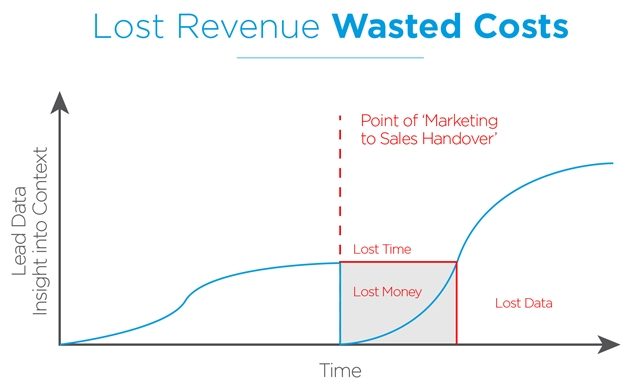Prospect self-education is making up more and more of the B2B (and high-value B2C) purchase journey. It used to account for perhaps 10% of the buying journey; now, depending on which research you trust, it forms 50-70% of the process. And in a few years it might be 90% for many categories.
Regardless of the ongoing debate about the actual numbers (which of course vary by industry), the trend is directionally correct, and we can safely assert that we are have entered the era of the "Self-Educated Buyer."
The Rise of the Self-Educated Buyer
The Web now provides a vast array of sources of information to prospective customers: discussion groups, user groups, LinkedIn, Facebook, and simple Google queries all provide endless sources of information to customers who let their fingers do the walking on a keyboard.
Organizations are themselves contributing to this phenomenon via demand-generation efforts that are powered by content that engages and informs prospects about their various topics of interest.
Businesses are well aware that if they don't "join the conversation" by creating relevant content that meets buyer needs, they risk becoming obsolete in an online world of full of contrary or more-compelling voices.
The Changing Cost of Marketing and Sales
The classic B2B model is for Marketing to get the prospect's name and contact information into the hands of a salesperson as quickly as possible.
The subsequent process is arduous and inefficient: Qualification and education may have to occur over several phone calls and face-to-face meetings. Each of those actions carries a cost—further exacerbated by the fact that a salesperson can focus only on one prospect at a time.
In the new paradigm, the self-educated buyer prefers not to engage with sales too soon. They want to engage at their own pace through Web-based channels to self-educate as individual buyers or as buying teams.

Image data source: CEB
In response, world-class organizations are developing digital engagement strategies, pipeline development programs, and costly content marketing activity to ensure that prospects and customers are educated earlier in their buying decision—without "forcing" a salesperson on them.
As well as creating a process that is better aligned with the behavior of the self-educated buyer, the positive cost/benefit of this arrangement should also be clear: Since Marketing deals one-to-many, Marketing's cost per engagement is much lower than that of Sales.
If Marketing serves more of the customer decision process, it also saves cost of sales.
Marketing: From Cost Center to Cost-Saver
With its new toolkit and increasing budgets, Marketing is moving down the funnel, eager to prove its worth before salespeople. In doing so, many marketing departments are also acting in the sales enablement arena.
So, with the caveat that the following suggestions include marketing and sales enablement, here are a few ways you can prove marketing value by saving sales costs.
1. Learn from Sales
The feedback loop between Sales and Marketing is crucial to optimizing and accelerating the purchase journey of the self-educated buyer. Sales has the best information on what problems and recurrent questions appear in the conversations with prospects. A strong marketing function listens to Sales, and ensures that recurrent or significant questions are addressed earlier in the purchase journey through quality content.
In our recent interview with the global content director of Emarsys, we learned that every content marketing initiative at the company is accompanied by a Sales briefing process that includes talking pieces, intelligent insights, though-provoking questions, and relevant customer anecdotes.
Opening and maintaining such open lines of communication means that Marketing is constantly in a position to be learning from Sales' frontline engagements with the customer.
2. Tightly define lead qualification
Getting the Sales and Marketing teams to build tighter definitions for qualification—and owning those collectively—allows a more collaborative approach and should prevent one team's blaming the other when things get tough.
Remember that qualification isn't just a means to qualify prospects: It also serves as a positive opportunity to identify leads that are not Sales-ready and therefore need to be further nurtured and educated via content.
When lead qualification criteria are differ within Marketing and Sales, the expectation gap leads to all kinds of problems. The key point here is that Marketing should work its hardest to produce leads that fit Sales' criteria, rather than operating in accordance with a different set of rules.
There will always be some drop-off between Marketing-qualified-leads and Sales-accepted-leads, but the larger that gap the more need for tighter and more clearly communicated lead-qualification criteria.
3. See what Sales sees
The Marketing-Sales divide is not just functional; often, it is technological as well. Marketing teams keep their eyes on their marketing automation software rather than also on what Sales teams see in their CRM-centric view. Divided dashboards often lead to divided departments.
It's important, then, for Marketing to have an understanding of how Sales sees the self-educated prospects that are passed through.
Since Sales will not learn about buyers and the specifics of their situation until late in the game, Marketing needs to think about how it can provide Sales with as much useful and actionable information as possible so that fewer resources are wasted on prospect research.
4. Provide Sales with lead context
Organizations that use marketing automation will use lead scoring as a means to make sure that only the most active of self-educated buyers are sent to Sales.
The problem is that lead scoring is only a measure of cumulative activity and doesn't necessarily identify what each prospect is interested in. The time saved by not having to make multiple calls can soon be lost because the same salesperson now has to dig into the prospect's URL history and try to work out what it is the prospect is actually interested in.
Since content is a vehicle for not just engagement but also insight, Marketing has a huge opportunity to add value to Sales by providing context, such as which content topics a prospect is interested in.

Image via idio
5. Put an SDR team in place
Your salespeople, usually an expensive resource, should be closing business with qualified customers, not educating raw leads, talking to people who don't want to talk to them, or, worse, talking to time-wasters and other unqualified prospects.
It makes much more sense to have an interim sales development rep (SDR) resource talking to leads and passing just the right ones on to Sales as booked meetings.
When sales reps can focus on closing business with qualified decision-makers, the economic gains are astounding.
Marketing Value Is About Saving Cost-of-Sales
The influence that Marketing has over the decision process is growing, but that doesn't undermine the continued importance of Sales.
At the point of lead handover, Marketing is hopefully supplying a well-qualified, educated, and interested person. But because most B2B deals take an average of five decision-makers to close, the job of Sales is not just to speak with that one person but to connect the dots among the various other decision-makers while outlining the challenge, reframing potential solutions, and positioning themselves as the ideal solution.
Doing all that certainly becomes easier when Marketing has done a good job of educating multiple decision-makers and played a part in that process of identifying challenges and reframing solutions.
While marketing—in particular content marketing—can often seem like a costly exercise, when viewed in light of the self-educated buyer it is the most cost-effective exercise for B2B organizations.




